projected unit credit and unit credit cost methods
This article discusses the technical details of Projected Unit Credit (PUC) and Pure Unit Credit (UC) attribution for both pension and OPEB plans.
Background
From first principles, we establish the following equation for the present value of a benefit (PVB):
![]()
where:
![]() age on the valuation date
age on the valuation date
![]() interest discount from decrement at time t to the valuation date
interest discount from decrement at time t to the valuation date
![]() probability of survival in active service for t years from age x
probability of survival in active service for t years from age x
![]() probability of decrementing in year beginning at time t (at age x+t)
probability of decrementing in year beginning at time t (at age x+t)
![]() present value at age x+t of $1 paid annually according to the given payment form (e.g., life annuity deferred to 65), including any COLAs or trend
present value at age x+t of $1 paid annually according to the given payment form (e.g., life annuity deferred to 65), including any COLAs or trend
![]() projected benefit at time t (at age x+t)
projected benefit at time t (at age x+t)
Note for OPEB plans: Throughout this document, please read ![]() as the present value of future claims and
as the present value of future claims and ![]() as the proration factor (equal to 1 for computing PVB).
as the proration factor (equal to 1 for computing PVB).
Accrued liabilities (AL) for Projected Unit Credit (PUC) and Pure Unit Credit (UC) give us the portion of the PVB attributed to past service (as of the valuation date). This is done by replacing the benefit![]() above with attributed benefits
above with attributed benefits ![]() and
and ![]() , respectively. Thus:
, respectively. Thus:
![]()
![]()
Normal Cost (NC) for PUC and UC gives us the portion of the PVB attributed to next year’s service (for the year beginning on the valuation date). This is done by replacing the benefit ![]() with
with ![]() and
and ![]() , respectively:
, respectively:
![]()
![]()
Because NC can be derived in parallel fashion, this article focuses on deriving AL.
Attribution Methods
The attribution method may be selected separately for each Benefit Definition you create in ProVal. ProVal offers the following attribution methods (also known as proration) for PUC and UC:
-
Accrual rate proration. This is the default setting in the pension modes.
-
Linear proration to decrement.
-
Linear proration to benefit eligibility.
-
Linear proration to a specified age (U.K. mode only).
-
Linear proration to full eligibility (OPEB mode only). This is the default setting in the OPEB mode.
Under the linear proration methods, ProVal spreads the entire benefit computed at each decrement age over the period from the age at which attribution starts (e.g., hire age) to the applicable age (i.e., age at decrement, benefit eligibility, a specified age or full eligibility).
Note that under the linear to full eligibility proration method, ProVal determines whether an active member is fully eligible based on age, service, points, etc. as of the valuation date, regardless of the assumed timing of decrements. This is done to be consistent with the proration used for attribution (as discussed in the following paragraphs).
Under accrual rate proration, attribution is done separately for each Benefit Formula Component found in the Benefit formula (or, in the OPEB mode, Gross Benefit Definition and/or Participant Contribution). This allows greater flexibility for attributing different parts of the benefit, such as minimums, offsets and frozen benefits.
As the name implies, accrual rate proration is driven by accrual rates. It follows that Accrual Definitions (and SubFormulas, if they contain Accrual Definitions) are the only types of Benefit Formula Component affected, because the other component types (Tables, Database Fields, Constants and, in the pension modes, Lump Sum Factors) do not have accrual rates and are assumed to be fully accrued as of the valuation date.
If you wish, for purposes of accrual rate proration, you can specify attribution rates that differ from the accrual rates. This is done by clicking the Attribution button in the Accrual Rates dialog box.
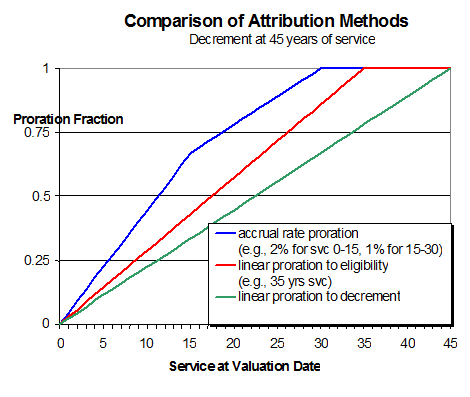
Note that linear proration to a specified age is available only in U.K. mode and will most commonly be used with benefits whose components include projected service. As a result of these limitations, this option has not been included in the chart above.
Projected Unit Credit
Under accrual rate proration, proration is applied to the projected value at decrement of each Benefit Formula Component that has accrual rates. It follows that Accrual Definitions (and SubFormulas, if they contain Accrual Definitions) are the only Benefit Formula Components that are prorated, because the other component types (Tables, Database Fields, Constants and, in the pension modes, Lump Sum Factors) do not have accrual rates and are assumed to be fully accrued as of the valuation date. Accrual Definitions are prorated by the ratio of cumulative accrual rates as of the valuation date to cumulative accrual rates at decrement. Finally, the Benefit formula (or, in the OPEB mode, Gross Benefit Definition and/or Participant Contribution) is then reevaluated using the prorated components.
For example, if the benefit formula is ACCDEF + TABLE + FIELD + CONSTANT + LSFACTOR, then the projected benefit is:
![]()
and the attributed benefit for PUC is:
![]() ,
,
where

In OPEB mode, the ratio 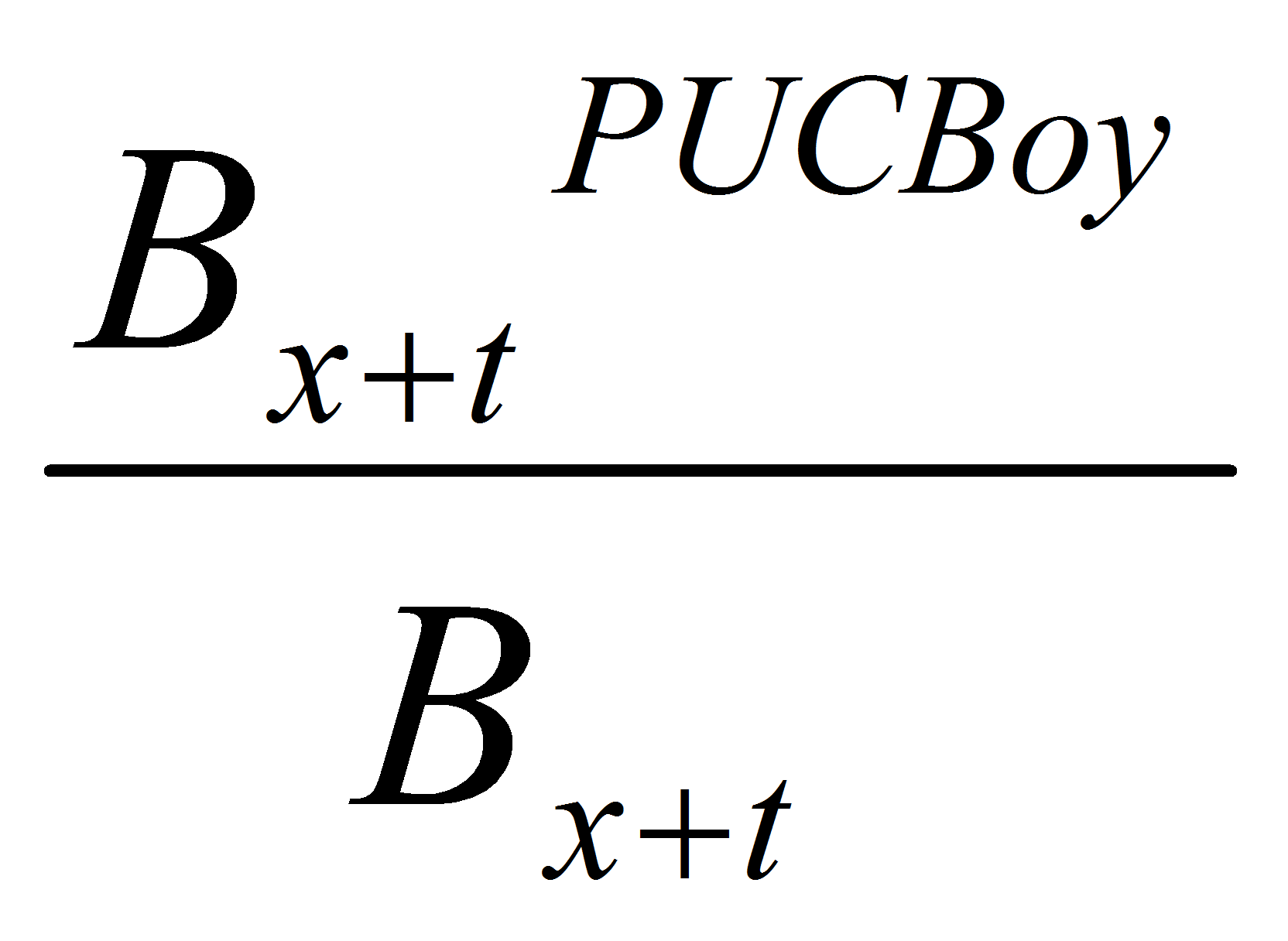 represents the cumulative attribution fraction for the benefit. The numerator and denominator represent the formula reevaluated at decrement age x+t, with and without prorated accrual definitions. Thus, it is important that the benefit formula be non-zero at decrement for accrual rate proration to work. For example, it will not work if the benefit has been multiplied by something like “#PMTAGE >=65”, resulting in a zero benefit at decrement for ages less than 65.
represents the cumulative attribution fraction for the benefit. The numerator and denominator represent the formula reevaluated at decrement age x+t, with and without prorated accrual definitions. Thus, it is important that the benefit formula be non-zero at decrement for accrual rate proration to work. For example, it will not work if the benefit has been multiplied by something like “#PMTAGE >=65”, resulting in a zero benefit at decrement for ages less than 65.
In a Valuation, you can check under Sample Lives the accrual rate proration of each component: see the Benefit Formula Component sample life report.
If there has been a change in benefit level between age x and age x+t, such as in a plan providing a monthly benefit of a stated dollar amount per year of service, and the new benefit level applies to service rendered prior to the date of change, ![]() will reflect the benefit level in effect at age x+t if the benefit increase has been coded in the Accrual Basis of the Accrual Definition (in an Accrual Basis Component with Increase Rates applied to it). However, if the benefit increase has been coded under the Accrual Rates topic of the Accrual Definition (by applying the new rates to all years),
will reflect the benefit level in effect at age x+t if the benefit increase has been coded in the Accrual Basis of the Accrual Definition (in an Accrual Basis Component with Increase Rates applied to it). However, if the benefit increase has been coded under the Accrual Rates topic of the Accrual Definition (by applying the new rates to all years), ![]() will reflect the benefit level in effect at time x (i.e.,
will reflect the benefit level in effect at time x (i.e., ![]() ). See the Frequently Asked Questions article entitled Flat Dollar Plan with Increasing Benefit Level for details.
). See the Frequently Asked Questions article entitled Flat Dollar Plan with Increasing Benefit Level for details.
For a cash balance component, ![]() and
and ![]() may include interest credits to decrement age (x+t) at your option. (See Custom Attribution Rates for details.)
may include interest credits to decrement age (x+t) at your option. (See Custom Attribution Rates for details.)
Note: If you wish, you may define PUC attribution rates separately from accrual rates. (See Custom Attribution Rates for details.) Thus the PUC attribution is affected but the benefit accrual is unchanged. Substituting separate attribution rates for PUC, this becomes:

Under linear proration to decrement, the projected benefit is prorated by the ratio of service at the valuation date to service at decrement. The attributed benefit for PUC is:
![]()
Under linear proration to age, the projected benefit is prorated by the ratio of service at the valuation date to the later of service at decrement and service at the specified age. The attributed benefit for PUC is:
![]()
![]()
![]()
where SA is the specified age for this attribution option. Note that this attribution option normally is used with benefits projected to the same age, SA, meaning that Bx+t = BSA for all decrement ages up to SA.
Under linear proration to benefit eligibility, the projected benefit is prorated by the ratio of service at the valuation date to service at the earlier of the date the member is first eligible for the benefit (as specified in the Benefit Definition) and the decrement date. Thus the attributed benefit is:
![]() , proration fraction not greater than 1.
, proration fraction not greater than 1.
Under linear proration to full eligibility, the projected benefit is prorated by the ratio of service at the valuation date to service at the earlier of the date the member is fully eligible for the benefit (as specified in the Plan Definition) and the decrement date. Thus the attributed benefit is:
![]() , proration fraction not greater than 1.
, proration fraction not greater than 1.
If full eligibility is attained at multiple dates following changes in a step rate table, then ![]() is replaced by
is replaced by![]() . That is, service to full eligibility varies by decrement age (i.e., the date the member is fully eligible for the benefit is re-determined at decrement ages at which the step rate changes). For an example of linear proration to full eligibility following changes in a step rate table, see Full Eligibility - OPEB Mode.
. That is, service to full eligibility varies by decrement age (i.e., the date the member is fully eligible for the benefit is re-determined at decrement ages at which the step rate changes). For an example of linear proration to full eligibility following changes in a step rate table, see Full Eligibility - OPEB Mode.
If there has been a change in benefit level between age x and age x+t, such as in a plan providing a monthly benefit of a stated dollar amount per year of service, and the new benefit level applies to service rendered prior to the date of change, ![]() will reflect the benefit level in effect at time x+t. See the Frequently Asked Questions article entitled Flat Dollar Plan with Increasing Benefit Level for details.
will reflect the benefit level in effect at time x+t. See the Frequently Asked Questions article entitled Flat Dollar Plan with Increasing Benefit Level for details.
The equations above apply when assuming beginning of year decrements. When assuming middle of year decrements:
-
Under accrual rate proration in the pension modes, an average value is used for the attributed benefit at decrement,
 , i.e.,
, i.e.,
![]()
-- and, likewise, ![]() .
.
· Under accrual rate proration in OPEB mode, the cumulative attribution fraction 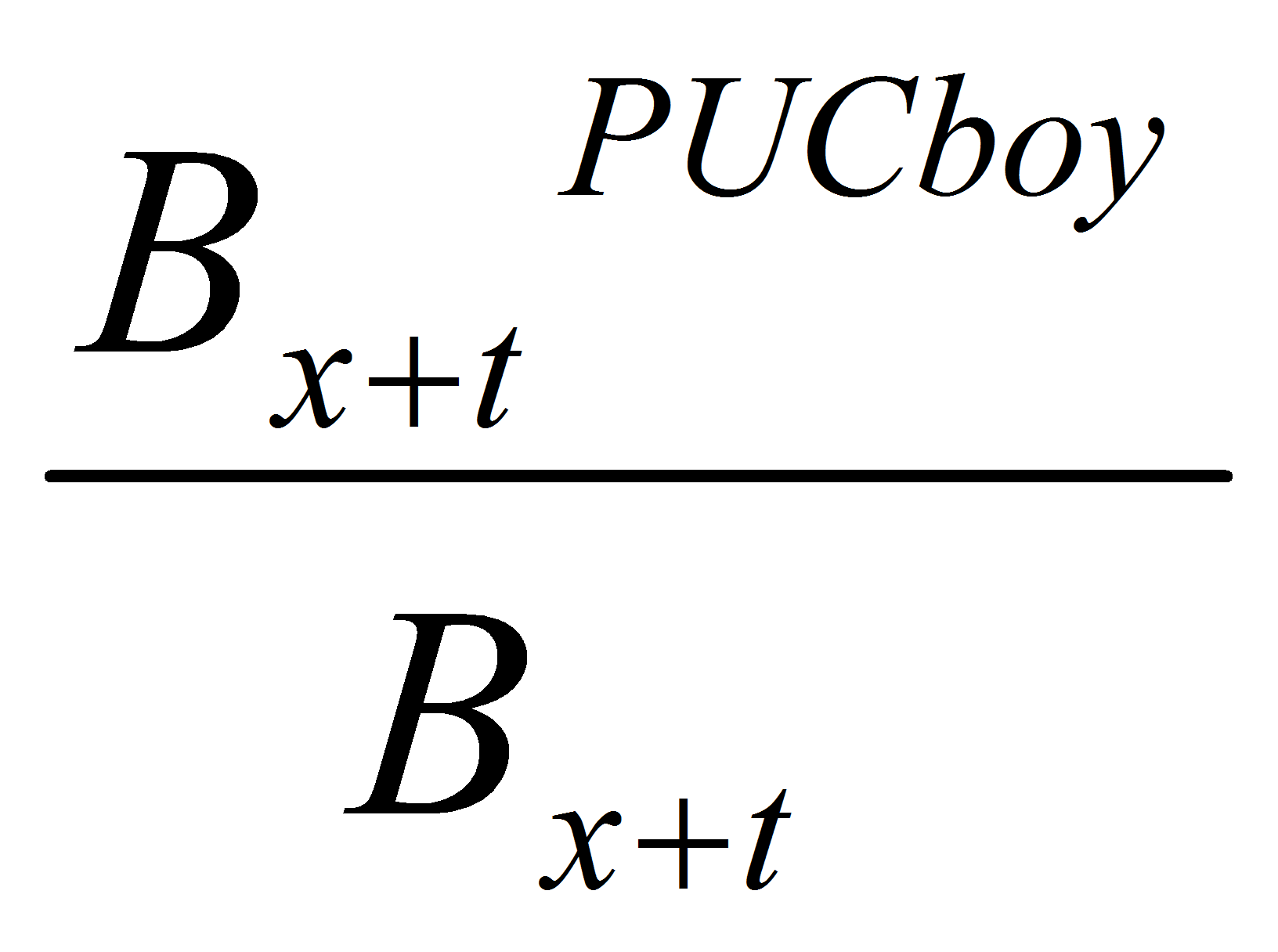 becomes
becomes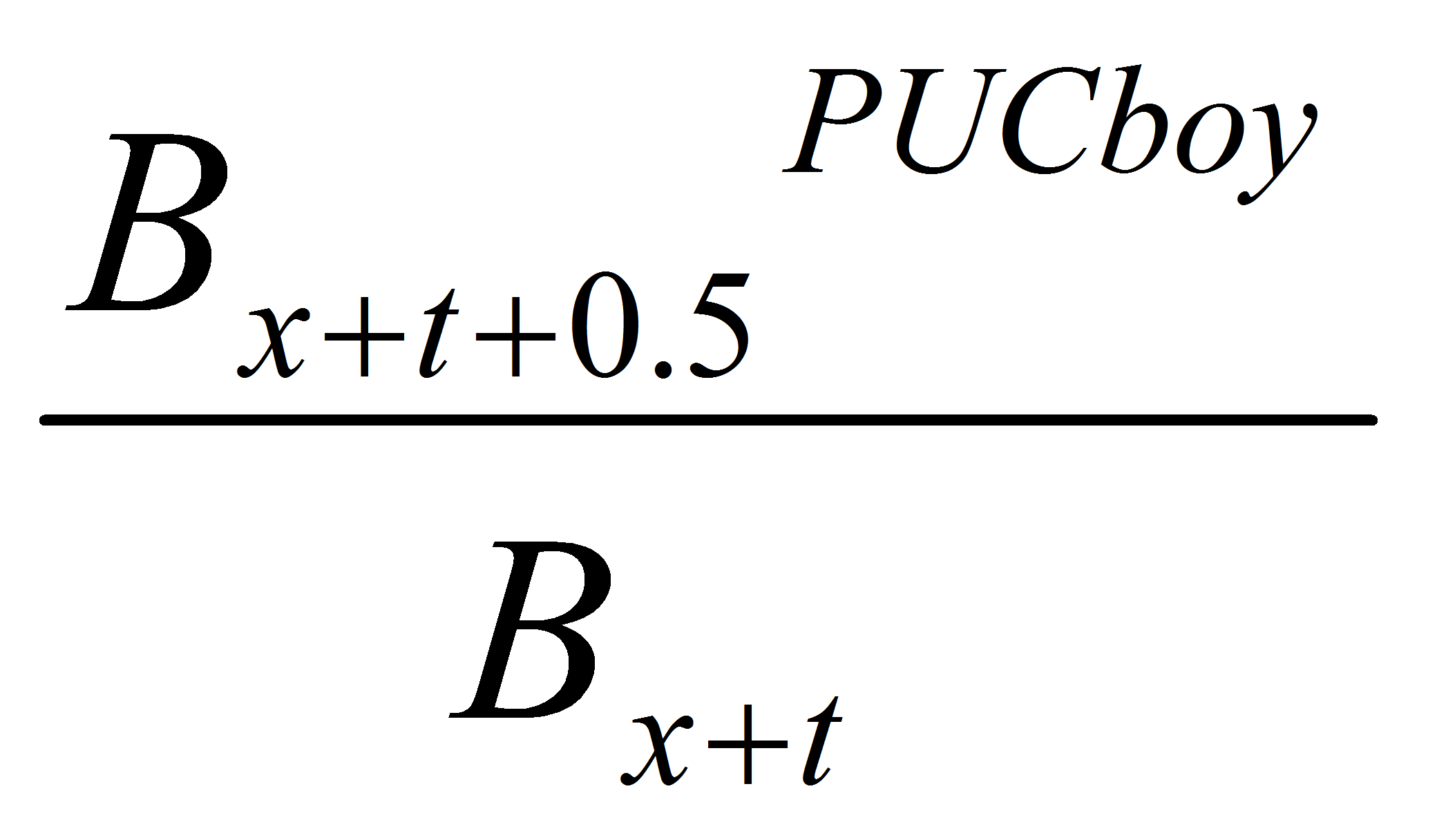 , where
, where ![]() is based on reevaluating the formula with accrual definitions prorated by
is based on reevaluating the formula with accrual definitions prorated by![]() . That is, each accrual definition’s proration fraction has an additional year of service rate accrual in the denominator. Likewise,
. That is, each accrual definition’s proration fraction has an additional year of service rate accrual in the denominator. Likewise, ![]() is based on reevaluating the formula with accrual definitions prorated by
is based on reevaluating the formula with accrual definitions prorated by![]() .
.
· Under linear proration to decrement in the pension modes, the projected benefit at decrement, ![]() , is replaced by an average benefit value,
, is replaced by an average benefit value, ![]() .
.
-
Under the linear proration methods (except the variation of linear proration to full eligibility that follows changes in a step rate table), service at decrement,
 in the denominator of the proration fraction, becomes
in the denominator of the proration fraction, becomes  , to reflect service through the middle of the year. Note, however, that full eligibility service,
, to reflect service through the middle of the year. Note, however, that full eligibility service,  in the denominator, reflects service to the date the member is fully eligible for the benefit (as specified in the Plan Definition), which does not vary with decrement timing.
in the denominator, reflects service to the date the member is fully eligible for the benefit (as specified in the Plan Definition), which does not vary with decrement timing.
Unit Credit
Before getting into the details, let’s first define the scope of Unit Credit attribution:
-
The Unit Credit cost method is available only in the pension modes.
-
Accrual rate proration is used most of the time. It is not common to use a linear proration method for UC.
-
If you do use a linear proration method, note that the accrued benefit is prorated, not the projected benefit. Therefore linear proration methods should be used only for benefits that don’t accrue over a period of service (e.g., $10,000 life insurance benefit, regardless of service).
Under accrual rate proration, proration is applied to each Benefit Formula Component that has accrual rates. It follows that Accrual Definitions (and SubFormulas, if they contain Accrual Definitions) are the only Benefit Formula Components that are prorated, because the other component types (Tables, Database Fields, Constants and, in the pension modes, Lump Sum Factors) do not have accrual rates and are assumed to be fully accrued as of the valuation date. Accrual Definitions are prorated by the ratio of cumulative accrual rates as of the valuation date to cumulative accrual rates at decrement. Finally, the benefit formula is then reevaluated using the prorated components.
For example, if the benefit formula is ACCDEF + TABLE + FIELD + CONSTANT + LSFACTOR, then the projected benefit is:
![]() and the attributed benefit for UC is:
and the attributed benefit for UC is:
![]()
where (by definition of the unit credit cost method) the attributed component value for ACCDEF is
![]() , with interest to decrement age (x+t) if the accrual format is cash balance.
, with interest to decrement age (x+t) if the accrual format is cash balance.
In a Valuation, you can check under Sample Lives the accrual rate proration of each component: see the Benefit Formula Component sample life report.
Note: If you wish, you may define UC attribution rates separately from accrual rates. (See Custom Attribution Rates for details.) However, separate attribution rates, generally, are not used under the unit credit cost method. One situation where you might want them is if you:
1) want UC to equal PUC without projected salary (i.e., accrual basis) and
2) have specified separate attribution rates for PUC.
When separate UC attribution rates are used, the attributed benefit for UC for the accrual definition component ACCDEF becomes:
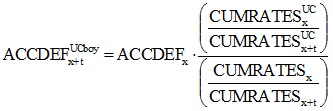
To see how this works, assume that ACCDEF has a final average accrual format. Then ![]() , so
, so
the UC formula above reduces to:
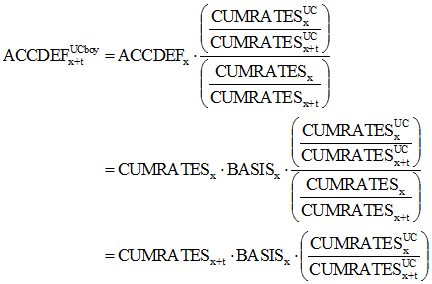
and the PUC formula above becomes:

Comparing the two formulas, we see that the only difference is the use of ![]() for UC but
for UC but ![]() for PUC (assuming that the same, custom, attribution rates have been specified for UC and PUC). That is, we’ve accomplished what we set out to achieve by using separate UC attribution rates: UC equals PUC without projected salary (i.e., without projected BASIS).
for PUC (assuming that the same, custom, attribution rates have been specified for UC and PUC). That is, we’ve accomplished what we set out to achieve by using separate UC attribution rates: UC equals PUC without projected salary (i.e., without projected BASIS).
Under linear proration to decrement, the accrued benefit is prorated by the ratio of service at the valuation date to service at decrement:
![]()
Under linear proration to age, the accrued benefit is prorated by the ratio of service at the valuation date to the later of service at decrement and service at the specified age:
![]()
![]()
![]()
where SA is the specified age for this attribution option. Note that this attribution option normally is used with benefits projected to the same age, SA, meaning that Bx+t = BSA for all decrement ages up to SA.
Under linear proration to benefit eligibility, the accrued benefit is prorated by the ratio of service at the valuation date to service at the earlier of the date the member is first eligible for the benefit (as specified in the Benefit Definition) and the decrement date. Thus the attributed benefit is:
![]() , proration fraction not greater than 1
, proration fraction not greater than 1
Linear proration to full eligibility is not applicable to UC (a pension-only cost method) because full eligibility is defined only in OPEB mode.
Vested Liabilities
The attribution method for vested liabilities is essentially unit credit accrual rate proration, but see the Technical Reference article entitled Vested Liability Calculation for details.
Service Definitions and Attribution
When you specify a Service Definition for linear proration to benefit eligibility or linear proration to full eligibility, it is used:
-
To determine the date that eligibility (benefit eligibility or full eligibility) is met, if service is required for eligibility. The service rounding rule is applied for this purpose.
When you specify a Service Definition for linear proration to decrement, linear proration to benefit eligibility, or linear proration to full eligibility, it is used:
-
To determine service for the attribution fraction (see equations above). The service rounding rule is not applied for this purpose. Theoretically speaking, this avoids discontinuities (cliffs) in the attribution fraction and weights each year of elapsed time equally. Special case: For linear proration to benefit eligibility, or linear proration to full eligibility, if the annual service accrual is 0, service for the attribution fraction (not service for determining when benefit eligibility or full eligibility is met) is assumed to increase at the rate of 1 per year. Thus, for a participant age 55 with 10 years of service at the valuation date and 0 annual service accruals, the attribution fraction for full eligibility at 80 points is (10 / 25). (Full eligibility is attained 15 years after the valuation date, when the participant is age 70 and has completed 10 years of service: 70 + 10 = 80 points.)
The following examples demonstrate how linear attribution to full eligibility works using three different Service Definitions. Service Definition 1 uses annual service accruals of 1 per year and no service rounding rule. Service Definition 2 introduces an annual service accrual of 0.8. Finally, Service Definition 3 introduces a service rounding rule.
Basic Inputs
1. Valuation date = 1/1/2005
2. Age on valuation date = 49
3. Decrement age = 65
(In the examples below, service at full eligibility is always less than service at decrement age. Since the attribution fraction’s denominator uses the lesser of the two, service at decrement won’t affect our examples. For simplicity, we’ve excluded it from the calculations below.)
4. Decrement timing = beginning of year
| Service Definition 1 | Service Definition 2 | Service Definition 3 | |
| Service Definition parameters | |||
| 5. Current Service | 4 | 4 | 4 |
| 6. Annual service accrual | 1 | 0.8 | 0.8 |
| 7. Service rounding rule | <none> | <none> | Nearest year |
| Full Eligibility = 10 years of service | |||
| 8. Full eligibility date | 1/1/2011* | 7/1/2012** | 11/15/2011*** |
| 9. Service at full eligibility, before rounding | 10 | 10 | 9.5 |
| 10. Attribution fraction = (5)/(9) | 4/10 | 4/10 | 4/9.5 |
| Full Eligibility = Age 55 | |||
| 11. Full eligibility date | 1/1/2011 | 1/1/2011 | 1/1/2011 |
| 12. Service at full eligibility, before rounding = (5)+(55–(2))*(6) |
10 | 8.8 | 8.8 |
| 13. Attribution fraction = (5)/(12) | 4/10 | 4/8.8 | 4/8.8 |
| Full Eligibility = Age 55 & 10 years of service | |||
| 14. Service at full eligibility, before rounding = greater of (9) and (12) |
10 | 10 | 9.5 |
| 15. Attribution fraction = (5)/(14) | 4/10 | 4/10 | 4/9.5 |
* 1/1/2005 plus (10-4) years
** 1/1/2005 plus (10-4)/0.8 years
*** 1/1/2005 plus (9.5-4)/0.8 years. Note that the full eligibility requirement is met after 9.5 years of service (before rounding) because the service rounding rule is to the nearest year.